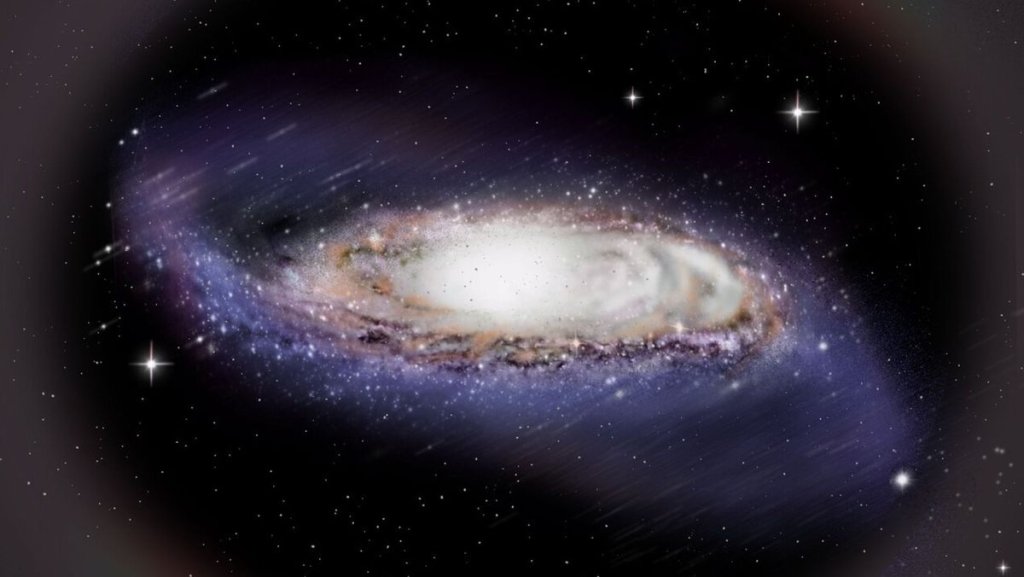The warp in the Milky Way’s spiral disk is precessing backward under the influence of the enormous mass of dark matter that forms an invisible halo around our galaxy, Chinese astronomers have discovered.
About one-third of all spiral galaxies have a distinct warp to their disk-shaped structure, like a vinyl record that has been bent. It’s usually the result of a variety of factors; a collision with another galaxy in the past is believed to be the primary culprit in causing the Milky Way’s warp in the first place, but further interactions with satellite galaxies and the intergalactic magnetic field, as well as the infall of vast clouds of gas, can also play their part. However, in the case of the Milky Way at least, the major player in maintaining the warp is the dark matter halo that surrounds the disk and exerts a torque on it.
This warp isn’t fixed. Its alignment with the rest of the galaxy moves — specifically, it “precesses.” Precession describes how the alignment of the warp changes with respect to the rotational axis of the galaxy, meaning that the peak, or node, of the warp precesses around the galaxy. It’s a variation of the same phenomenon that causes spinning tops to wobble.
Measuring the warp’s rate of precession, however, has proven challenging in the past. Previous estimates have attempted to use the vertical motion of bright, but old, giant stars as tracers to calculate the rate of precession. However, such tracers are notoriously imprecise, and results based on them had suggested — counter to theory — that the disk is precessing prograde (in the same direction as the rotation of the rest of the galaxy) and not retrograde (backward with respect to the galaxy), as had been expected.
Related: What is dark matter?
Now, astronomers led by Yang Huang of the Chinese Academy of Sciences have used another, more accurate tracer in the form of Cepheid variable stars to make the most accurate measure of the warp’s precession yet, finding it to be moving retrograde after all.
Cepheid variables are pulsating massive stars. Their period of pulsation is linked to how intrinsically bright they are, and based on their luminosity, we can calculate exactly how far away they must be. This makes them great tracers for mapping the warp.
Huang’s team achieved their results by way of what they call the “motion picture” method. Using data from the European Space Agency‘s Gaia astrometric spacecraft, which is measuring the positions, motions and properties, including the age, of more than a billion stars, Huang’s team identified a sample of 2,613 Cepheids with a variety of ages.
“Age is key to measuring the precession rate of the disk warp,” say the authors in their research paper. “We obtained a motion picture of the disk warp by mapping the three-dimensional distributions for Cepheid samples of different ages.”
Each Cepheid retains information on its position in the warp when it was born, so by grouping the Cepheids into different age ranges and mapping them, Huang’s team were able to show the shape and position of the warp at different points in time over the past 200 million years. By then running the individual maps together, like a motion picture, they were able to see the warp precessing. They found that it is precessing in retrograde fashion after all, at a rate of 2 kilometers (1.24 miles) per second for every kiloparsec (3,261 light-years) of space. Or, in more intuitive units, it is precessing backward around the galaxy by a rate of 0.12 degrees every million years.
What’s more, the motion picture also shows that the precession rate decreases with distance from the galactic center, which in the long term will lead to greater warping of the disk. Models indicate that this decrease is the result of the dark matter halo that is exerting the torque being oblate, or flattened, in shape.
The shape of the dark matter halo is important because it acts as a data point that theorists can plug into models that attempt to predict what dark matter is made of (such as WIMPs or axions). It also gives clues about the formation history of the Milky Way galaxy and how it has been assembled through mergers with other, smaller galaxies and gas clouds, collisions and interactions that have helped shape the invisible dark matter halo.
The discovery of the precession rate of the warp is described in a paper published on June 27 in Nature Astronomy.

